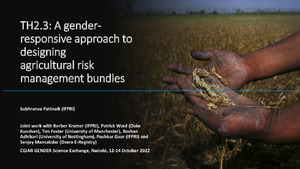TH2.3: A gender-responsive approach to designing agricultural risk management bundles
Abstract
Smallholder farmers are exposed to various risks, and because of their large risk exposure, agricultural insurance premiums are often too expensive to be affordable to smallholder farmers. In our study context, for instance, commercially viable insurance premiums are so high that the average farmer would be willing to pay only about 8 percent of the premium. Reducing farmers' risk exposure by incentivizing the adoption of risk-reducing practices and technologies, for instance through discounts to low-risk farmers, could offer a significant breakthrough in lowering insurance premiums. At the same time, in the presence of gender differences in existing cultivation practices, there is a chance that women farmers may find these practices and technologies more inaccessible or costly to afford than men, and in that case, incentivizing adoption of risk-reducing practices and technologies could disadvantage women more than men. We therefore quantify gender gaps by interviewing 462 male and 447 female farmers in the state of Odisha, India, on barriers to adopting risk-reducing technologies and cultivation practices. We find that women are more exposed to flood and post-harvest losses than men, and that they face more challenges hiring labour, increasing their labour costs. We conclude that in this context, gender-responsive insurance policies should promote access to and adoption of risk-reducing practices and technologies that not only minimize exposure to floods and post-harvest losses but also are less labour intensive. The findings of this study will directly inform financial institutions involved in the implementation of an agricultural insurance scheme.

